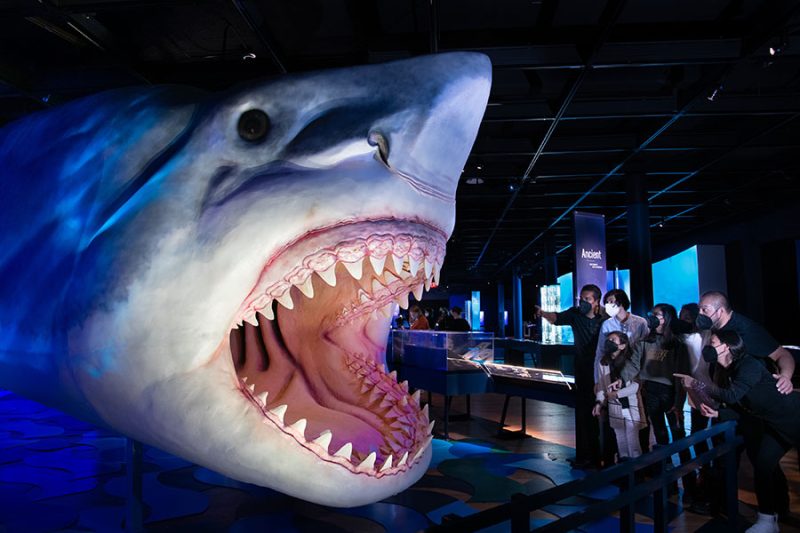People have been intrigued by sharks for as long as we have been exploring the oceans. Fixed in the public imagination as toothy, fearsome predators, sharks are far more fascinating, and more complex, than their depiction in popular culture. The American Museum of Natural History’s new exhibition Sharks opening December 15, brings to life the incredible diversity of sharks with dozens of life-sized models, ranging from 33 feet to 5 inches long, and offers visitors a unique look at prehistoric and modern species, their habitats and hunting styles, and the conservation threats these spectacular animals face today.
The evolutionary history of sharks is extraordinarily long, predating the appearance of trees, flowering plants, and even dinosaurs on our planet. Today, more than 540 species of sharks and over 670 species of their close relatives—the rays, skates, and chimaeras—
inhabit nearly all the world’s marine environments, from coral reefs to the polar seas, and even freshwater rivers. While the terrifying monster from the movie Jaws is what many might imagine when they think of sharks, today scientists are uncovering many surprising facts about this diverse group of ancient fishes. The exhibition will showcase fossils from the Museum’s extensive collections, current Museum research, and a spectacular “parade” of sharks highlighting ancient and modern shark species, including the prehistoric mega-predator megalodon, the “Tyrannosaurus rex of the seas,” which was so large it preyed on whales.
“We are delighted to give our visitors the chance to meet and learn about sharks in this intriguing, eye-opening exhibition that is also great fun,” said Ellen V. Futter, President of the American Museum of Natural History. “This ancient and highly diverse group of animals is so much more than the popular depictions of them, and this exhibition uses amazing technology and techniques such as touch-free interactives and the Museum’s world-renowned model-making to bring sharks up close and personal for visitors of all ages.”
Visitors to Sharks will explore the anatomy, diversity, and behavior of sharks and their relatives through encounters with tiger sharks, great whites, and other familiar favorites along with little-known animals such as the torpedo ray, the longnose chimaera, and the tiny dwarf lanternshark, which glows in the dark and is small enough to hold in your hand. Through dozens of life-sized models, fossils, touch-free interactives, and dynamic media presentations, Sharks reveals the many secrets of these top predators and demonstrates that while they pose few threats to people, we represent a serious danger to their future on the planet.
“The perception of sharks—that they are large, vicious predators to be feared— couldn’t be farther from the truth. Sharks and their relatives are an incredibly old, diverse group of organisms that are critical to maintaining the health of the ecosystems they inhabit. In fact, humans are much more of a threat to sharks than they are to us,” said John Sparks, curator in the Department of Ichthyology at the Museum and curator of Sharks. “We hope people walk away from this exciting exhibition with a new appreciation for sharks and understand they are magnificent creatures that should be revered, not feared.”
WHAT MAKES SHARKS UNIQUE?
About 450 million years ago, one branch of fishes split off from the rest. Most fishes—and their descendants, the reptiles, birds and mammals—have bony skeletons. But members of the branch of fishes consisting of sharks, rays, skates, and chimaeras have skeletons made of cartilage. Unlike the cartilage in our noses and ears, this cartilage is coated in a hard layer of minerals that makes it strong as well as lightweight and flexible.
As visitors enter the exhibition, they will be surrounded by dynamic media displays of sharks gliding alongside them, inviting them into this colorful, engaging experience. Sharks explores the characteristics that make these animals unique through a touchless interactive exhibit of a life-sized shark that offers an inside look at shark anatomy and biology, including regenerative teeth and the variety of ways in which different shark species produce offspring. Visitors will also explore photos and illustrations of fossils from the ancient shark relative Doliodus, which had a mix of features that helped scientists recognize that sharks evolved from fishes with bony skeletons, solving a long-running mystery about their origins.
DIVERSITY OF SHARKS
When we think of sharks, we may picture iconic species like the great white. But over the course of their nearly half a billion years on Earth, sharks have evolved into a stunning diversity of forms. Sharks explores this range through a “parade” of over two dozen life-sized shark models that spans the entire length of the exhibition. Media projections, video, and a 37-foot long, 10-foot tall projection screen unique to this exhibition highlight the diversity of sharks swimming in Earth’s waters today. Scenes in this installation and a portion of other footage throughout Sharks have been provided by Discovery’s Shark Week.
“For over 30 years, Discovery’s Shark Week has been the home of captivating content about these majestic and misunderstood animals of the ocean,” says Nancy Daniels, chief brand officer, Discovery & Factual. “We are excited to give exhibition visitors an opportunity to feel like they are ‘swimming’ alongside these animals. At Discovery, our goal is to always create opportunities where the general public leave understanding more about these complex creatures than they did before. We are proud to be part of this exhibition and to help the American Museum of Natural History achieve this goal.”
The shark “parade” is organized into the following categories:
Ancient
The gaping jaws of a scientifically accurate model of megalodon—the biggest predatory fish of all time—greets visitors at the start of the exhibition. The 27-foot long model depicts the front portion of this ancient ocean giant, which grew as big as 50 feet, showcasing its gargantuan teeth. Before it became extinct over 3.6 million years ago, this shark overlapped with early human relatives like Australopithecus, the hominid best known from the fossil skeleton nicknamed “Lucy.” Also featured in this section are fossils from the Museum’s collections, including those from Helicoprion, an extinct species known for its unusual tooth whorl, 50-million-year-old Heliobatus, which closely resembles modern freshwater rays, and other shark relatives like Cladoselach, which had a recognizably shark-like body but lived more than 350 million years ago.
Predator/Prey
The human fear of sharks reflected in movies and popular culture does not represent their actual danger. A handful of species that hunt large marine mammals occasionally attack humans, with most of the 10 or so annual deaths from shark bites caused by just three species: the tiger, bull, and great white sharks. In fact, you’re more likely to be struck by lightning than bitten by a shark. Most species of sharks feed on smaller sea animals, such as fish, shrimp, crabs, clams, and tiny plankton—and their feeding styles are as diverse as their prey.
Realistic models of species featured in this section include those depicting the pelagic thresher shark, which sports a tail nearly as long as the rest of its body; the shortfin mako, the world’s fastest shark; and the Atlantic devil ray, great white shark, and others. Illustrations, videos, and skull casts explore the varying methods of shark hunting behaviors and adaptations, preferred prey, and the range of shark jaw and tooth anatomy, including how sharks constantly shed and replace worn and broken teeth. A touchless interactive exhibit also lets visitors compare the range of defense mechanisms of sharks and rays with those of other animals, including frogs and honeybees.
Biggest
The biggest fish in the world is a whale shark. But other sharks are tiny. The size of each species depends on how it evolved and adapted to its environment. The shark “parade” continues in this section with models that demonstrate the great diversity of shark body sizes, from the gigantic, 33-foot whale shark, a filter feeder that consumes lots of little plants and animals, to the recently discovered and diminutive 5.5-inch pocket shark. And while it is indeed small enough to fit in a pocket, this shark gets its name from its “pocket” gland, from which, researchers’ hypothesize, it squirts glowing liquid to attract prey. Visitors will also learn how scientists use the spots on whale sharks like fingerprints to identify individual fish through a touchless, interactive pattern-matching game and learn about new discoveries including a great white nursery near New York City, how manta rays filter-feed, and a kitefin shark that is the largest-known glowing vertebrate.
Super sensers
Like all animals, sharks and their close relatives depend on their senses to find food, avoid danger, move around, and find mates. In order to live in such widely varying environments, these species have evolved some extraordinary sensing abilities, including detecting electromagnetic fields and the direction of low-frequency sounds. Through a range of videos, dynamic media and animations, visitors will learn about sharks’ senses, including, like all fishes, the lateral line system; which consists of numerous pressure sensors arranged in lines down the side of their body to help detect the location of potential predators and prey. Detailed models of super-sensing sharks and rays, including the spotted eagle ray and biofluorescent swell shark, which glows bright green in the presence of sunlight to identify itself to other members of its species, are featured in this section, along with a model of a hammerhead shark and the saw-like rostrum of a sawfish. Visitors can also “hunt like a hammerhead” in an interactive exhibit that invites visitors to direct a shark, which uses electro reception, a sixth sense that allows them to detect invisible electromagnetic fields.
Around the World
From above, the ocean just looks like water. But beneath the surface are coral reefs, kelp forests, and sunless depths. Sharks, rays, and chimaeras have evolved to live in all these habitats, as well as along sunlit coastlines and in muddy river deltas. Some live only in rivers, like one of the world’s most rare sharks, the Ganges river shark. Others, like the Greenland shark, live in frigid Arctic waters. And while some sharks and rays stay in the same region their whole lives, many are constantly on the move, sometimes migrating thousands of miles a year.
In this section of the exhibition, visitors can discover the specialized adaptations that help sharks succeed in their environments through a habitat matching game and information about the “white shark café,” a place thousands of miles offshore where scores of great white sharks congregate. This section features models of species like the long-migrating blue shark, the cownose ray, which travels in schools of up to 10,000 individuals, and the slow-moving but deadly goblin shark, which lives in the ocean’s depths and can rapidly project its jaw out of its mouth to catch fast-moving prey.
The “parade” concludes with an interactive that invites visitors to “be a shark” by standing in front of a video mirror that tranforms them into various species.
SHARKS AND US
In the center of the gallery, two sections examine humans’ interaction with sharks, looking at fears versus facts of sharks’ threat to humans and highlighting their vulnerability to human activities on the planet.
Dangerous
What is it about sharks that fascinates and frightens us? America’s fear of sharks arose relatively recently, along with the popularization of seaside holidays, outsized media attention on isolated shark attacks, and the original summer blockbuster, Jaws, which crystalized feelings of fear in the collective American imagination. In truth, the majority of shark species are small and harmless. Here, visitors will learn about the history of our fear of sharks and simple tips to avoid getting bitten by a shark or stung by a stingray. An interactive exhibit compares the relative danger of shark bites with more common scenarios, such as mosquito or snake bites.
Vulnerable
Sharks are killed at astounding rates by humans. In the early 2000s, estimates of shark deaths caused by humans ranged from 63 million to 273 million per year, along with millions of skates and rays. These numbers have gone down since then—but not because people hunt them less. This section explores the various threats facing sharks as well as efforts by dedicated people working hard to protect them through conservation solutions such as shark sanctuaries in the island nation of Palau and sustainable sea food products.
EXHIBITION ORGANIZATION
Sharks is curated by John Sparks, curator in the Department of Ichthyology in the Division of Vertebrate Zoology. Sparks previously curated Unseen Oceans, Life at the Limits: Stories of Amazing Species, The Exosuit, and Creatures of Light: Nature’s Bioluminescence. His recent research explores the role that bioluminescence and biofluorescence play in the diversification of both shallow-reef and deep-sea fishes. Sharks has also drawn on the expertise of John Maisey, curator-in-charge emeritus, fossil fish, Division of Paleontology, whose research focuses on early chondrichthyans and shark evolution.
The exhibition is designed and produced by the American Museum of Natural History’s award-winning Exhibition Department under the direction of Lauri Halderman, vice president for exhibition.
Sharks will open to the public on Wednesday, December 15, 2021. Museum Members will be able to preview the exhibition from Friday, December 10, through Sunday, December 12.
Photo credit: D. Finnin/© AMNH











